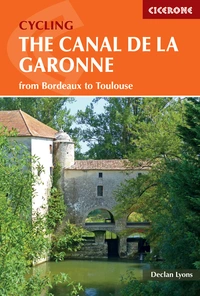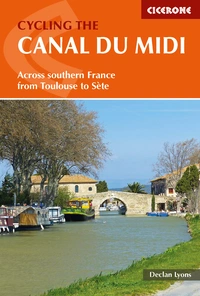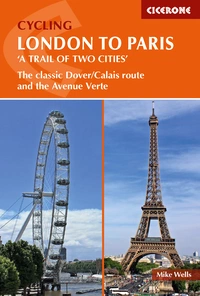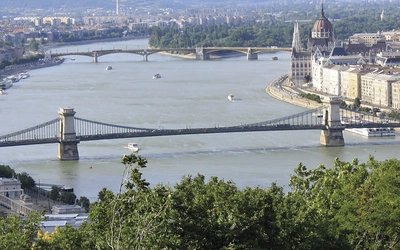The Canal de la Garonne from Bordeaux to Toulouse – a cyclist’s dream
There are few places better than France to tour by bike. And the Canal de la Garonne offers one of the best routes on traffic-free asphalted cycle paths and small country roads. The canal dates from the mid-19th century and winds its way through pastoral countryside linking medieval towns and villages. The canal is a product of the late industrial age. Where possible, it follows a straight line; its locks follow a standard design. It runs close to the River Garonne and the railway linking Bordeaux and Toulouse – often between the former transport route (the river) and the train that would replace it. All would be eclipsed by road transport, and motorways now carry freight that once would have chugged along on canal barges.
Cycling the Canal de la Garonne
From Bordeaux to Toulouse
£17.95
A guidebook for cycling France's Canal de la Garonne, describing 290km of cycle route from Bordeaux to Toulouse, where it connects with the Canal du Midi. Describes a 135km excursion to the Atlantic Ocean, with detours to many historical towns and villages along the route. With information on accommodation, facilities and cycle shops on route.
More information
Stage 1: The history and culture of Bordeaux
Bordeaux is enchanting in summer, with approximately half the city classified as a UNESCO heritage site. Its classical and neo-classical buildings lend a sense of grace and opulence to the streets. One of the city's highlights is Le Miroir d’Eau, the world's largest water mirror, where the sun's rays glint off the surface as adults and children paddle in its cooling waters. The joyful sounds of their shrieks and laughter echo through the air, enhanced by the intermittent water sprays creating a refreshing mist. This lively scene epitomizes the vibrant, yet relaxed, atmosphere of Bordeaux. The city is an excellent starting point for a cycling tour to Toulouse along the Canal de la Garonne, perfectly blending historical charm with the buzz of a cosmopolitan university city.
Historically known as the 'Sleeping Beauty' of French cities, Bordeaux underwent a dramatic transformation from the 1950s to the 1990s. Once seen as a sleepy backwater, it revitalized its image by cleaning up its buildings, developing its docks, opening up public spaces, and integrating a modern transport system. Crucially for cyclists, Bordeaux established an extensive network of cycle paths, allowing for safe and enjoyable cycling throughout the region. These improvements have made Bordeaux a dynamic city that seamlessly integrates its rich history with contemporary vitality, making it a pleasure to explore on two wheels or on foot.
For those exploring the city, the compact center is best navigated on foot to avoid the hassle of constantly locking and unlocking a bike. The city's wealth, built on trade via the Garonne River, is reflected in its grand mansions and public buildings. Key sites to visit include Place de la Bourse, where the buildings are beautifully reflected in the water mirror, and Place de la Comédie, home to the impressive Grand Théâtre and Intercontinental Grand Hotel, which hosts Gordon Ramsay’s two Michelin-starred restaurant. Yet, some of Bordeaux's most charming spots are its narrow streets and shaded parks. The Esplanade des Quinconces, covering 12 hectares, is the largest city square in Europe, providing an open, airy feel. Other tranquil spots, such as the Jardin Public, offer a serene escape from the urban bustle, allowing visitors to experience the city’s blend of historical grandeur and modern-day charm.
This stage leaves the bustle of Bordeaux behind and follows a converted railway line, now an asphalted cycle track, that winds through woodlands, farmland, and vineyards, connecting one village to another. At the start, you'll encounter carrelets on the riverbank—traditional fishing huts with nets that are winched into the river. This 18th-century fishing method persists today, with about 400 carrelets along the estuary, though you'll only see a few as you cycle. This stage features several bastide towns, characterized by their strict grid layout and uniformly designed houses. At their heart is usually a marketplace, often covered and surrounded by arcades, with the church nearby but set back from the square. Sauveterre-de-Guyenne exemplifies this architectural style, retaining its town gates and central arcades.
Stage 2: Marmande, France’s tomato capital
This stage takes you from Sauveterre-de-Guyenne to Marmande, reaching the Canal de la Garonne at Fontet. Along the way, you pass a medieval mill and the striking town of La Réole. Fontet, a small village, has two notable curiosities: a medieval dovecote near the canal and a museum dedicated to matchstick models. Gerard Gergerès has meticulously crafted these models over 30 years, including one of the Palace of Versailles.
At Fontet, you can choose to head to Castets-en-Dorthe, where a chateau overlooks the Garonne valley and canal junction, or continue towards Toulouse. Between Castets and Fontet, a 13th-century mill worth a detour is one of many you’ll encounter on the cycle. The path runs between the canal and the Garonne River, with scenic views until you turn off for Marmande.
Marmande, steeped in history, perches over the Garonne with impressive ramparts. Its charming old town features narrow streets and half-timbered houses. L’Église Notre-Dame, a 13th-century church at the town center, maintains a unified architectural design despite renovations. Known as France's tomato capital, Marmande also boasts orchards of kiwis and plums along the cycle route.
Stage 3: Through France’s tobacco heartland
The stage from Marmande to Buzet-sur-Baïse traverses lush farming countryside, transitioning from the French tomato capital to its former tobacco capital, Tonneins, before reaching Buzet, renowned for its high-quality wines.
Mas-d’Agenais is a highlight, featuring a church housing a painting of Christ crucified by the Dutch painter Rembrandt. This village, with numerous attractions, boasts the Saint Vincent church, built between the late 11th and early 12th centuries.
En route to Buzet, you'll encounter large black wooden barns, séchoirs or drying houses, where tobacco leaves are dried. While tobacco is no longer popular among French smokers, it is still exported. Buzet, situated on the Baïse River, has a rich history dating back to prehistoric times, with the present town evolving around its 10th-century chateau. Known for winemaking since Roman times, Buzet's wine cooperative has embraced environmental sustainability, producing bee-friendly, vegan, low-alcohol, and organic wines. Their efforts contribute to preserving biodiversity, reminding cyclists of the importance of such innovative businesses in maintaining the beauty of the countryside.
Stage 4: Towards the great prune capital
Agen boasts several notable attractions, including the aqueduct carrying the canal across the Garonne, a dramatic piece of engineering and a high point for cyclists. Known as the center of France’s plum production, Agen's prunes (dried plums) are renowned as ‘Prunes Agenais’. The path from Buzet offers quiet, rural stretches, with highlights like the hillside church in Clermont-Dessous, offering panoramic views of the Garonne and its plain. Nearby towns like Bruch, with its Roman origins and medieval fortifications, and Sérignan-sur-Garonne, are worth a detour. Bruch, in particular, features half-timbered houses dating back to the 15th and 16th centuries, showcasing its rich history. As you approach Agen, you'll cross the Agen aqueduct over the Garonne, a marvel of engineering spanning 580m with 23 arches, offering stunning views of the town and river. For the best views and photo opportunities, head to the cycle path below the aqueduct.
Stage 5: Moissac’s ancient monastery
The route from Agen to Moissac offers diverse attractions. Near Castelculier, you'll find ancient Roman remains with an exhibition of artifacts and a 3D film depicting life in the 4th century. Valence d’Agen showcases English bastide architecture, complete with old buildings, three lavoirs, a dovecote, and bustling marketplaces, adding to its charm. A short detour leads to Auvillar, hailed as one of France's most beautiful villages, definitely worth the brief cycle to explore.
The highlight of this stage is Moissac. Cycling alongside the Tarn river, you'll be greeted by the striking red-bricked Napoleon bridge upon entering the town. Moissac's main attraction is its seventh-century Abbey, a UNESCO heritage site. Its 11th-century cloisters, boasting 76 marble columns across four galleries, stand as the oldest intact cloisters in Europe.
Stages 6 + 7: Towards Toulouse
Between Moissac and Toulouse lie two short but delightful stages, passing through the charming towns of Montech and Montauban before reaching the vibrant city of Toulouse.
Just before Montech, you'll encounter the Pente d’Eau, a fascinating water slope lifting boats up or down a 13.3m slope, avoiding five locks. Montauban, situated on its own canal branch, showcases exquisite pink-bricked buildings reminiscent of Toulouse's architecture. The town's lively narrow streets, cafés, and squares, particularly the Place Nationale with its impressive pink-bricked architecture, invite exploration.
As you near Toulouse, the landscape shifts abruptly from rural to urban, marked by the distant hum of the motorway. The journey culminates in the Port de Bassin de L’Embouchure, where the canal meets the Canal du Midi, linking to the Mediterranean. Toulouse, known as the ‘Rose City’ for its red-bricked buildings, boasts stunning architecture spanning the 15th to 17th centuries. Its narrow streets and sunlit squares offer a delightful biking experience, with the Place du Capitole standing as a prime example of Toulousain architecture. Exploring Toulouse's treasures warrants a few days' leisurely exploration.
Cycling the Canal de la Garonne
From Bordeaux to Toulouse
£17.95
A guidebook for cycling France's Canal de la Garonne, describing 290km of cycle route from Bordeaux to Toulouse, where it connects with the Canal du Midi. Describes a 135km excursion to the Atlantic Ocean, with detours to many historical towns and villages along the route. With information on accommodation, facilities and cycle shops on route.
More information












